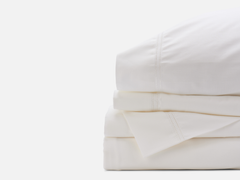We wanted to take a second to address a concern... or maybe it's just a question that needs answering! We hear this a lot, "Why such a low thread count?", and, "Why are your sheets better at 140 thread count than my 700 thread count sheets from the department store? Please explain". Well... here we go.
The Definition:
Thread count does not indicate quality. Instead, thread count is defined as "the number of horizontal and vertical threads per square inch". However, using thread count to indicate quality has been stuck in the American psyche.
The Great Marketing Strategy:
The idea of using thread count to determine quality was initiated in the mid-1990s. By the early 2000s, the myth about thread count had reached a new level of absurdity with companies posting 1000 plus thread counts. Today, we see this marketing tactic extended into grocery stores. Labels using the words "organic" or "non-GMO" are slapped on products to indicate something is "healthy" or "healthier". We've seen this used on orange juice... folks... there IS NO GMO orange. That's not even a thing. It's just a marketing ploy to make you THINK you are buying "better". AND IT WORKS. Similarly, we look to thread count to indicate quality but that is just as misleading as a non-GMO orange.
Facts:
For the most part, anything above 250 threads per square inch has been manipulated and the manufacturers are counting plied yarns to make up the entirety of the thread count. A plied yarn is a yarn that has multiple strands of yarn twisted together to create a stronger, longer yarn. Often cheaper, weaker cotton is used and requires the extra strands of yarn for strength.
So, What Should You Look For When Buying The Perfect Bedding?
Fiber:

Weave:

Manufacturing:

The Final Finish:

In Conclusion
I hope we've cleared up some questions! It's hard to be a knowledgable consumer when there is a lot of misinformation and marketing out there. As always, we're happy to answer any and all questions about our cotton, our process, and our products!
- Anna, Co-Founder and farmers daughter









